Welcome to a culinary journey through the heart of Beijing, where flavors are as rich as the city’s history. In this blog, we’ll explore the diverse and delectable world of Beijing’s cuisine, a treasure trove of culinary delights that have delighted both locals and travelers for centuries. Beijing, not only the capital of China but also a food lover’s paradise, offers a tantalizing array of dishes that tell stories of tradition, innovation, and a deep connection to the city’s vibrant culture.
From the world-renowned Peking Duck to lesser-known but equally captivating street eats, we’ll take you on a gastronomic adventure that traverses the city’s ancient alleyways, modern food scenes, and everything in between. Join us as we savor the essence of Beijing’s food culture, exploring the iconic and the hidden gems that make this city a foodie’s dream destination.
Beijing Roast Duck (北京烤鸭)
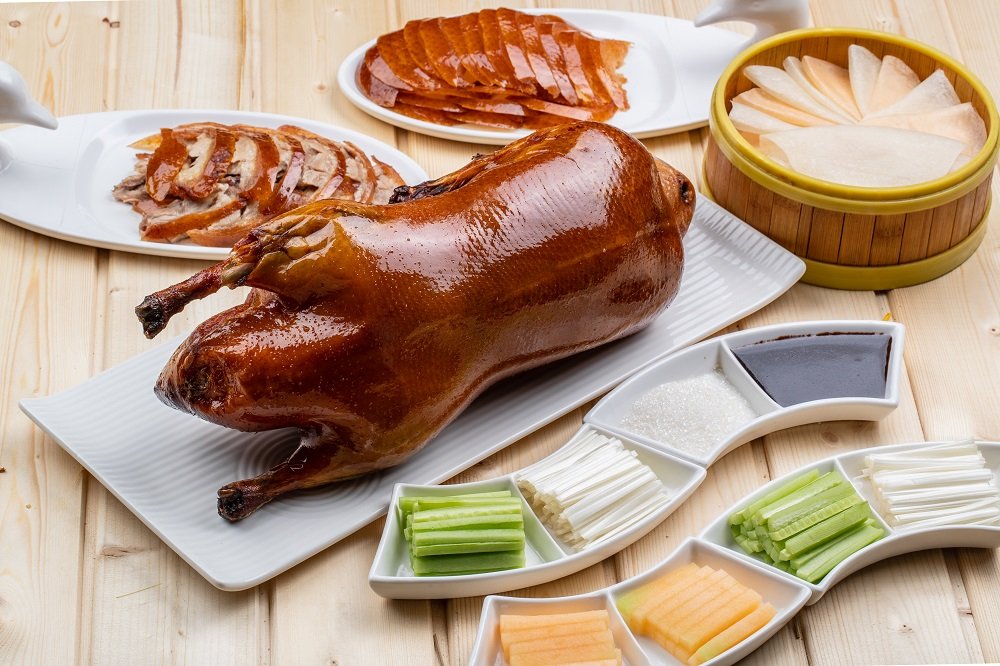
Beijing Roast Duck is one of China’s traditional delicacies and is considered the pinnacle of Beijing cuisine. It is often hailed as the “First Dish of China” and is a must-try for tourists, both domestic and international, visiting Beijing.
The history of Beijing Roast Duck can be traced back to the Yuan Dynasty (1271-1368). During that period, many Huizhou and Yangzhou merchants residing in Beijing developed a fondness for roasted duck, leading to the establishment of numerous duck restaurants. By the Ming Dynasty (1368-1644), Beijing Roast Duck had already become a royal cuisine. During the Qing Dynasty (1616-1912), it was officially included in the imperial menu, gradually gaining popularity among the city’s residents.
Beijing Roast Duck is characterized by its golden, crispy skin that’s not greasy, and tender, succulent meat that’s flavorful. Typically, the duck is sliced thin with both skin and meat, then served with condiments like shredded scallions, cucumber slices, and sweet bean sauce. It’s rolled into thin pancakes and eaten. Additionally, the duck bones can be used to make a delicious soup. This classic dish perfectly combines color, aroma, taste, and presentation.
Copper Mutton Hot Pot (铜锅涮肉)

Copper Mutton Hot Pot is a traditional delicacy of old Beijing. In old Beijing, it was customary to use charcoal-fired copper pots for instant-boiled mutton. Copper pots have excellent heat conductivity, quick heating, and, when the flame temperature is the same, the temperature of the copper pot will be higher than that of an iron pot. This results in the lamb being more tender, with a better texture, allowing you to truly savor the deliciousness of the meat.
Authentic instant-boiled mutton emphasizes a simple and clear broth, a testament to the purest flavors. The clear broth is enhanced with just a few ingredients: red dates, wolfberries, seaweed, ginger slices, and green onion segments—no need for any added oils. The perfect companion for instant-boiled mutton is undoubtedly sesame sauce. This sesame sauce is made with sesame, oyster sauce, cilantro, scallions, and various other seasonings, creating a rich and layered flavor profile. The delightful combination of fragrant sesame and peanuts with the fresh and tender lamb leaves a lingering taste, making it an unforgettable experience.
Lamb Spine Hot Pot (羊蝎子火锅)

Old Beijing’s lamb spine hotpot is a fusion of traditional Beijing flavors with modern hotpot techniques. Lamb spine, despite its name, is actually the part of the lamb’s spine that includes the tenderloin and spinal cord. Its name comes from its resemblance to a scorpion (蝎子).
This part of the meat is tender and juicy, low in fat but high in protein, and rich in calcium. Especially when simmered for an extended period, lamb scorpion becomes incredibly flavorful and nutritious, making it a delightful addition to hotpot cuisine.
Beijing Lamb Hotpot (北京涮羊肉)
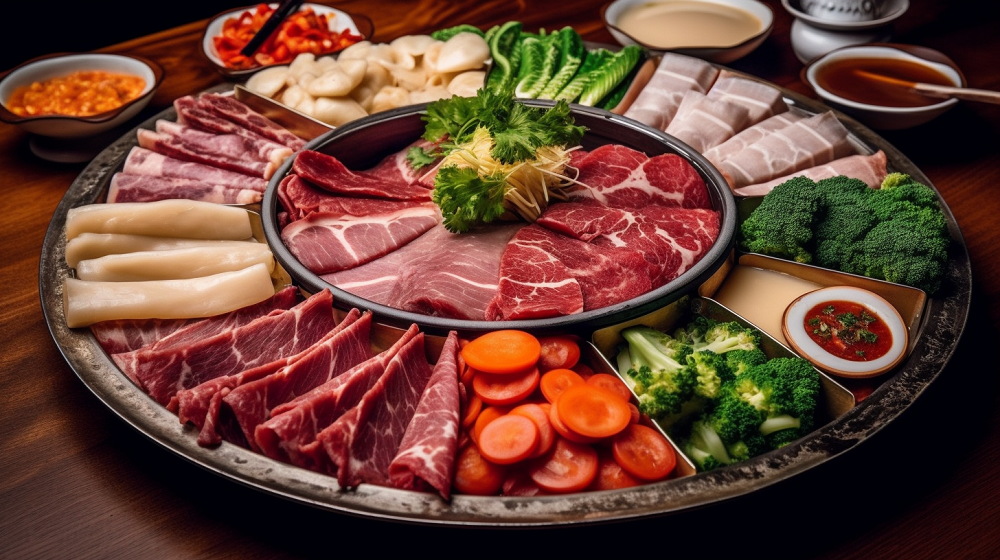
Beijing Lamb Hotpot is a delicious dish featuring tender lamb as the main ingredient. The meat is succulent and flavorful, typically enjoyed by dipping thinly sliced lamb and vegetables into a boiling broth. This combination ensures a satisfying meal without feeling overly heavy.
To prepare, the lamb is thoroughly cleaned, deboned, and trimmed of any excess fat or tendons. It’s then sliced into thin, wide pieces, approximately 12 centimeters in length and 2 centimeters in width. Various condiments such as soy sauce, shrimp sauce, sesame paste, and chili oil are provided in small bowls, while fermented bean curd and chives are served on small plates.
In a hotpot, chicken broth or water is heated until boiling. Diners use chopsticks to briefly submerge the lamb slices in the hot liquid, typically for about one to two minutes. When the meat turns a pale white color, it’s quickly removed and dipped into the various flavorings provided, creating a delightful culinary experience.
Donkey Burger (驴肉火烧)

Donkey Burger in Beijing has gained popularity rivaling that of Peking Duck. Sometimes, it even surpasses Peking Duck in preference. Whether you’re wandering through the streets and alleys of Beijing or visiting tourist spots, you’ll find small stalls and century-old shops selling roasted Donkey Burger everywhere. Many tourists visiting Beijing not only want to savor Peking Duck but also make it a point to try Donkey Burger, known for their delicious taste and affordable prices.
Moreover, the nutritional value of donkey meat should not be underestimated. Donkey meat is not only rich in nutrients like protein, calcium, and iron but also contains linoleic acid, which is not easily obtained from fish, as well as various essential amino acids for the human body. It is considered a very healthy food choice.
Noodles with Soybean Paste (炸酱面)

Noodles with Soybean Paste, as the name suggests, is a dish made by mixing noodles with fried sauce. Soybean paste, a sauce made by stir-frying various ingredients like doubanjiang (broad bean paste), minced meat, and minced garlic, is flavorful and spicy. It enhances the texture of the main ingredient, making you crave for more.
Noodles with Soybean Paste is an ancient traditional dish that has been a part of Beijing’s culinary culture since the Qing Dynasty. It’s even hailed as one of the four traditional Beijing delicacies, signifying its esteemed status.
In the streets and alleys of Beijing, whether in upscale restaurants or from street vendors, you can find Noodles with Soybean Paste everywhere. It has become a representation of Beijing’s culinary culture, making it one of Beijing’s culinary calling cards.
Shredded Pork in Sweet Bean Sauce (京酱肉丝)

Shredded Pork in Sweet Bean Sauce, often simply called “京酱肉丝” (Jīng jiàng ròu sī) in Chinese, is a highly renowned dish in Beijing cuisine, ranking among its classic specialties. This dish primarily uses lean pork, combined with sweet bean sauce, scallions, ginger, and various seasonings, cooked using the unique northern Chinese cooking technique known as “酱爆” (jiàng bào), one of the “六爆” (liù bào) techniques.
Once prepared, it offers a perfect balance of savory and sweet flavors, with a rich aroma of sauce. Beijing Shredded Pork in Beijing Sauce typically features tenderloin as the main ingredient and is cooked using the “jiàng bào” method. It is commonly served with shredded scallions and thin pancakes, delivering a delightful combination of salty-sweet tastes and a uniquely rich sauce flavor.
Quick-Fried Tripe (老北京爆肚)

Quick-Fried Tripe is a famous traditional snack in the culinary cultures of both Tianjin and Beijing, often operated by Hui Muslim vendors. The history of Quick-Fried Tripe can be traced back to the Qianlong era of the Qing Dynasty (1616-1912), and it was a staple in Qing Dynasty halal restaurants and street stalls in Beijing.
There are two main types: quick-fried lamb tripe and quick-fried beef tripe. To prepare fresh lamb or beef tripe (referring to the honeycomb tripe and the reticulum) is thoroughly cleaned and cut into thin strips. These strips are then quickly blanched in boiling water and served with a dipping sauce made from oil, sesame paste, vinegar, chili oil, tofu soup, chopped cilantro, and scallions. The result is tender and succulent tripe with a delightful crispy texture and a flavorful taste.
Stewed Offal (卤煮)

Stewed Offal, typically consists of tripe, intestines, and lungs, which are stewed in a rich broth. When served, these ingredients are removed from the broth, cut into small pieces, and drenched in the flavorful soup. To enhance the taste, it’s common to add garlic paste, chive blossoms, fermented bean curd, chili oil, and vinegar.
Stewed Offal is a beloved dish among the people of Beijing. The tripe is sliced with a special cross-cutting technique, tofu is shaped into triangles, and the intestines and lungs are diced into small pieces. A ladle of the rich broth is poured into the bowl containing these ingredients. When served, the hot and steaming bowl is a delicious blend of flavors, with the tripe absorbing the broth without becoming too sticky, and the meat retaining its tenderness. Among these components, the small intestine is often considered the most flavorful – tender, rich, and free from any unpleasant odor.
Fried Sausage (炸灌肠)

Fried sausage is a traditional and unique snack of old Beijing, belonging to the Beijing cuisine. Authentic fried sausage is made by frying sausages in lard extracted from pig intestines, giving it a distinctive aroma. However, due to health concerns, the use of lard from pig intestines is now rare in making fried sausages. When preparing fried sausages, the sausages are first sliced, then fried in a pan until they bubble and become crispy on both sides. Finally, they are taken out and drizzled with a mixture of salted water and garlic juice before being eaten while still hot.
Stir-Fried Liver (炒肝)
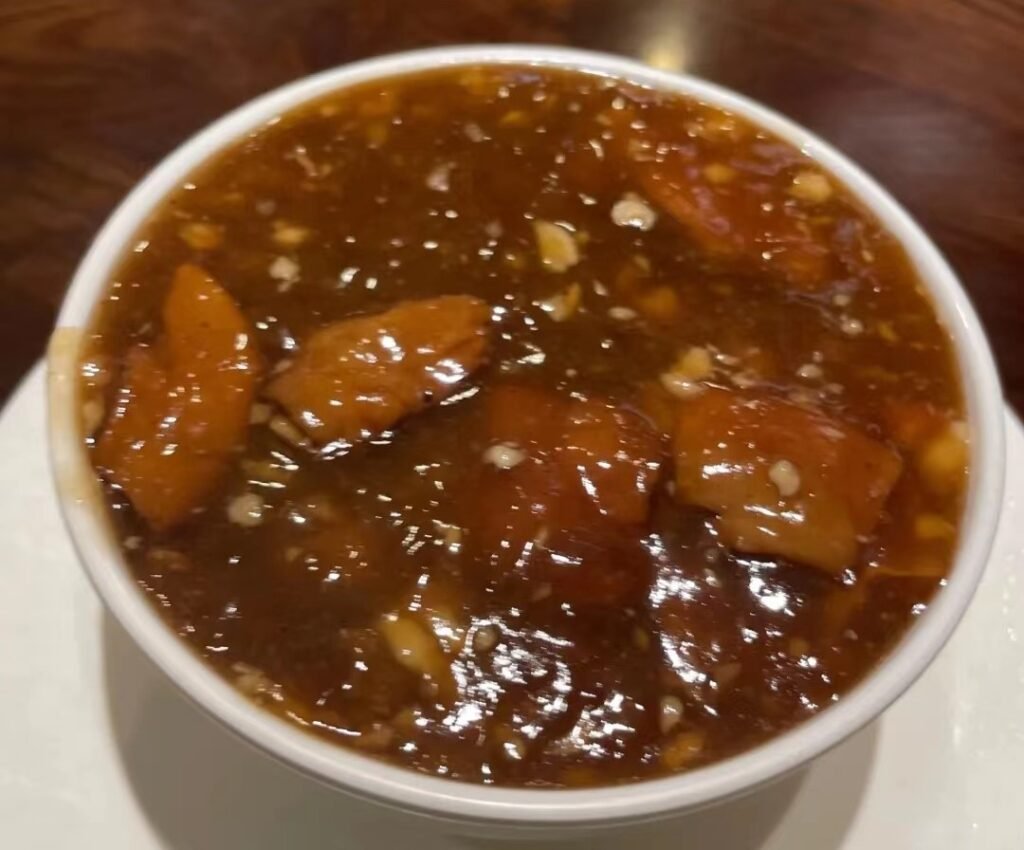
Beijing stir-fried liver is a famous Han Chinese snack made primarily from pig intestines and pig liver, with garlic and starch used as secondary ingredients. The dish is known for its shiny oil-red sauce, the richness of the liver, and its strong flavor that isn’t overly greasy.
Please note: Despite the name, “stir-fried liver” isn’t actually stir-fried. It’s prepared by boiling, and besides liver, it includes fatty intestines, usually in greater quantity than the liver. Starch is added at the end to thicken the sauce, and constant stirring is required, giving it a “stir-fried” feel.
Deep-fried Dough Cake (糖油饼)

Deep-fried Dough Cake, as one of the unique snacks among old Beijing’s breakfast options, was a classic combo with a bowl of soy milk at breakfast stalls in Beijing fifty years ago. It’s a cherished memory of the era before the 1980s.
Back then, there were breakfast stalls selling freshly fried sugar oil pastries and fried dough sticks all over the streets and alleys. The enthusiastic calls of the vendors, the freshly fried sugar oil pastries, dough sticks, and delicious soy milk are all flavors from that era.
When you take a bite, the deep-fried dough cake is crispy on the outside, with a rich aroma from the caramelized sugar on the surface. There’s also a layer of sesame paste that’s not overly sweet but becomes increasingly fragrant as you chew. When paired with a hot and fragrant mutton offal soup, smooth tofu pudding, and warm soy milk, it creates an exquisite and delightful meal.
Doornail Meat Pie (门钉肉饼)

Doornail meat pie is a traditional Halal snack in Beijing, named for its resemblance to the doornails found on ancient city gates. The preparation of this meat pie is similar to regular pastries, but instead of being flat, doornail meat pies are cylindrical, about 3 centimeters high and 5 centimeters in diameter.
Doornail meat pies are made by chopping the tender and marbled parts of beef into a filling, which is then mixed with ingredients like sesame oil, onions, fresh ginger, and Sichuan peppercorns. They have a crispy exterior, tender interior, a delightful aroma, and a burst of flavorful broth when you bite into them, making them a unique and delicious treat.
Fried Chop Rice Cake (驴打滚)

Fried Chop Rice Cake also known as “Rolling Donkey,” is a traditional snack originating from the northeastern regions of China, particularly in the old Beijing and Tianjin areas. Its finished product exhibits three distinct colors: yellow, white, and red, making it visually appealing.
The name “驴打滚” (“Lǘ dǎ gǔn”) is derived from the final step of the preparation, where it is sprinkled with yellow soybean flour. This step resembles the playful rolling of a wild donkey in the yellow earth of the outskirts of old Beijing, hence the name “Rolling Donkey.”
The ingredients used in Fried Chop Rice Cake include corn flour, soybean flour, crystal sugar, white sesame seeds, sweet-scented osmanthus flowers, shredded green and red silk, and melon seeds. The preparation involves three main steps: forming the dough, making the filling, and shaping the pastries.
The finished Fried Chop Rice Cake pastries are coated with soybean flour, giving them a golden appearance. The sweet bean filling is soft and delicate, offering a unique flavor. The bean filling melts in your mouth, releasing a sweet and fragrant taste, making it a traditional and beloved snack suitable for all ages.
Candied Hawthorns on Sticks (冰糖葫芦)

Candied hawthorns on sticks are a traditional Chinese snack with origins dating back to the Southern Song Dynasty. Wild fruits, often hawthorns, are skewered onto sticks and coated with maltose syrup, which hardens quickly when exposed to the air. This snack is commonly enjoyed during the winter months in northern China. It’s typically made using hawthorns, resulting in a delightful combination of sweet and sour flavors.
In the past, you could find candied hawthorns on sticks everywhere, from teahouses and theaters to streets and alleys. They are often featured in films and documentaries related to old Beijing, making them an iconic snack associated with the city.
Miancha/Seasoned Millet Mush (面茶)
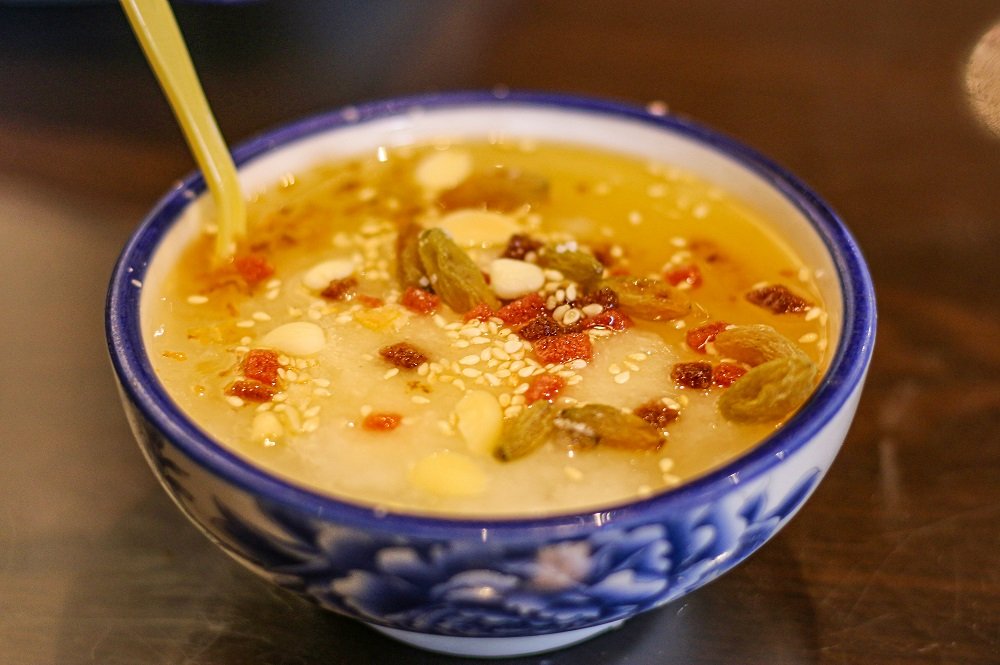
Miancha is a unique and traditional snack popular in the Beijing-Tianjin region. Unlike traditional tea, Miancha consists of a thick, porridge-like mixture made from cooked millet flour, which is scooped into a bowl. The distinctive aspect of Miancha is the drizzling of sesame paste over its surface. Using a spoon, the sesame paste is lifted and drawn into thin threads over the Miancha.
When enjoying Miancha, the traditional Beijing way involves holding the bowl in one hand, pursing the lips close to the bowl’s edge, and sipping while making a circular motion. This method ensures that both the Miancha and sesame paste mix together harmoniously, creating a delightful and unique flavor with every bite.
Douzhi/Fermented Mung Bean Milk (豆汁)

Douzhi is a unique snack of old Beijing with a history dating back 300 years. It’s made from mung beans, and after extracting starch to make products like starch noodles, the remaining residue is fermented to produce Douzhi. Douzhi is rich in protein, vitamin C, dietary fiber, and sugar, and it’s believed to be good for digestion, detoxification, and cooling the body.
However, while Douzhi is beloved by some for its distinctive taste, it’s not universally accepted due to its strong fermented aroma. This unique sour and tangy flavor can be off-putting to many, especially those not accustomed to it, making it a taste that is difficult to appreciate for some people, especially those from outside Beijing.
Ma Doufu/Fermented Bean Curd (麻豆腐)

Ma Doufu is of the same nature as Douzhi and is made from the same raw materials and methods. It is a byproduct of making green bean starch noodles and starch. After fermenting the Douzhi, it is heated, and the liquid that flows down after being filtered through cloth is Douzhi, while the residue left on the cloth, after removing excess moisture, is Ma Doufu. Like Douzhi, it also has a special fermented sour fragrance. Just as Beijingers have a fondness for Douzhi, they also have a special love for Ma Doufu.
Typically, when preparing Ma Doufu, it is stir-fried with mutton fat, yellow soybean paste, along with soybean or mung bean sprouts, and preserved vegetables until it becomes sticky and greenish-gray. After stir-frying, red chili oil is drizzled on top, creating a colorful dish with red, green, and yellow. It has a rich and savory taste, with a balanced blend of sourness and saltiness, making it uniquely flavorful.
Almond Tofu (杏仁豆腐)

Almond tofu is a famous traditional sweet dessert in old Beijing. It is primarily made by grinding sweet almonds into a paste, boiling them with water, and then allowing the mixture to cool and solidify into blocks, hence its name resembling tofu.
Almond tofu can be considered a true beauty among old Beijing snacks. Its taste is not only silky and delicate but also, according to traditional Chinese medicine theory, almonds are good for the lungs and regular consumption can nourish and whiten the skin, enhancing one’s appearance from the inside out. Almond tofu has a refreshing taste, making it especially suitable for consumption during the summer months.
Xiaodiao Pear Soup (小吊梨汤)
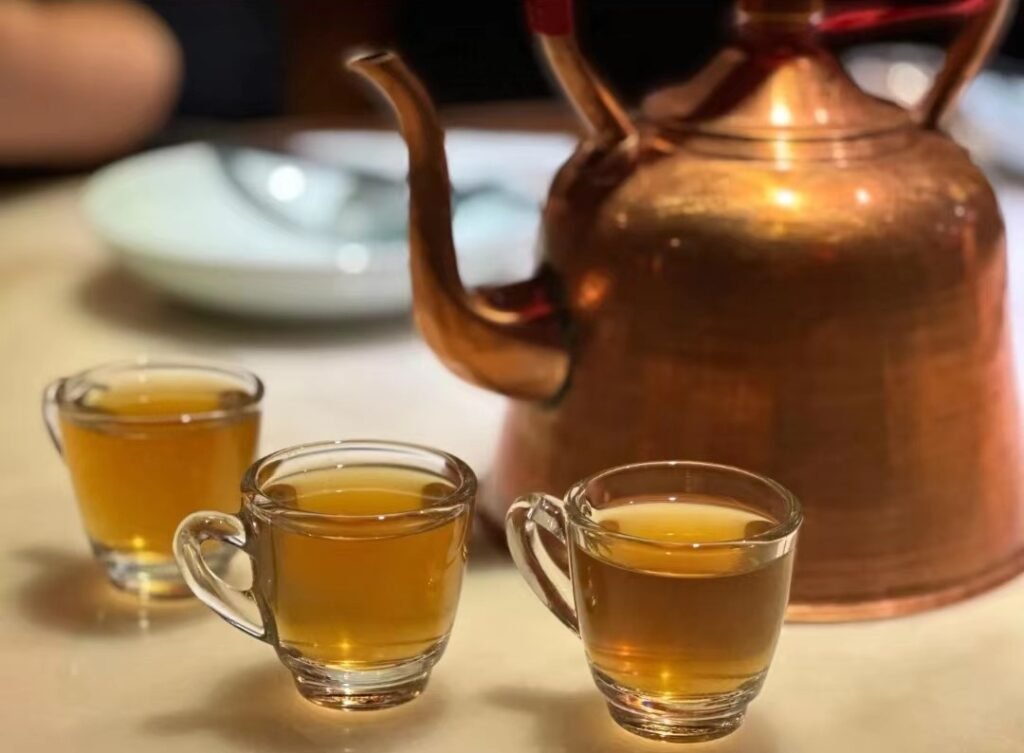
In Beijing, as winter arrives, you can often see signs outside restaurants advertising Xiaodiao Pear Soup. Because winters in Beijing are quite dry, and indoor heating can sometimes lead to discomfort, people like to use nourishing foods to alleviate these sensations, and Xiaodiao pear soup is one excellent option for this purpose.
In the past, you could find Xiaodiao pear soup in restaurants and eateries throughout the streets and lanes of the capital city. It was as famous as Douzhi (fermented mung bean milk) in old Beijing. The main ingredients include snow pear, yellow rock sugar, white fungus, wolfberries, green plums, and water.
Snow pears are known for their lung-moistening and cough-relieving effects. Yellow rock sugar contains more natural components from sugarcane compared to white rock sugar. White fungus, also known as silver ear fungus, has properties that invigorate the blood, clear heat, moisten the lungs, nourish yin, and boost heart and brain function. Wolfberries are rich in various amino acids and nutrients like betaine, zeaxanthin, and anthocyanins. Green plums have the effects of regulating qi, calming the mind, relieving coughs, alleviating pain, and treating typhoid fever and heat-related diarrhea, as well as reducing swelling and detoxifying the body.
Conclusion
As our culinary expedition through Beijing’s diverse cuisine comes to an end, we hope you’ve enjoyed this flavorful journey as much as we have. From the first bite of crispy Peking Duck to the last sip of fragrant tea, Beijing’s gastronomic landscape offers a sensory experience like no other. The city’s rich history, diverse culture, and innovative spirit are beautifully reflected in its food.
Whether you’re planning a visit to Beijing or simply indulging in armchair travel, remember that the capital’s culinary heritage is an integral part of its identity. These flavors, traditions, and the passion of its people will continue to shape the city’s vibrant food scene for generations to come.
Thank you for joining us on this delicious exploration of Beijing’s cuisine. We look forward to sharing more culinary adventures with you in the future. Until then, may your taste buds continue to savor the world’s delectable wonders.



